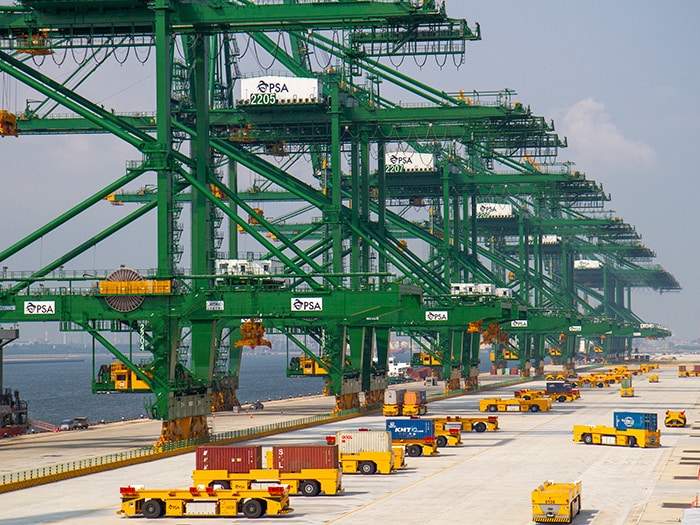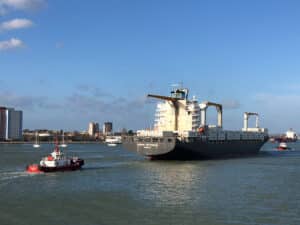
Op-Ed: Singapore’s Tuas Port is pioneering automation transformation
Written by Heather Ervin
When PSA recognized the need for operational resilience and adaptability to maintain a competitive edge and accommodate growth, it set out on a mission to build the world’s largest fully automated port. Credit: PSA Tuas Port
By Ho Vee Leung, Regional Head IT, Southeast Asia, PSA Singapore
The Port of Singapore Authority’s Tuas Port is on the path to becoming the world’s largest automated container terminal, reaching an annual handling capacity of 65 million Twenty-Foot Equivalent Units (TEUs) once it reaches full operational capacity in the 2040s.
Tuas Port has embraced automation and is establishing an innovative command center to oversee operations and maintenance. This has allowed PSA to streamline its supply chain and provide enhanced support to PSA’s valued customers in managing cargo flows. As a crucial component of this digital transformation, event-driven architecture (EDA) was selected as the backbone for the critical distribution of information.
The growing imperative of port automation
When PSA recognized the need for operational resilience and adaptability to maintain a competitive edge and accommodate growth, it set out on a mission to build the world’s largest fully automated port.
The first phase of Tuas Port opened in September 2022, with the entire port when completed by 2040. When completed, Singapore’s handling capacity will be doubled, and PSA will service vessels more than 400m in length. It will also work in tandem with the airport, to strengthen the current connection between the nation’s air and seaports, allowing the economy to benefit from greater trade volumes.
In the meantime, Tuas Port has now grown to eight berths, which have increased Singapore’s handling capacity amidst the supply chain crisis of past years. Most of the work at PSA is performed by Automated Guided Vehicles (AGV), while creating new job opportunities for the 500 people that currently work there.
To support this massive undertaking, PSA turned to an event-driven architecture (EDA) platform—underpinned by Solace—to orchestrate automated operations and maintenance activities.
Elevating port efficiency through EDA
At Tuas Port, the world’s largest fleet of over 200 AGVs, transports containers within the port 24 hours a day, 7 days a week. Regular transmission of instructions to each AGV are crucial for port operations and is achieved through the adoption of Solace PubSub+ to provide timely and reliable event delivery. By harnessing EDA, Tuas Port gains the ability to process vital data as events unfold, facilitating timely and informed decision-making.
Acting as a resilient “shock absorber,” EDA ensures seamless flow of information, guaranteeing in-order delivery of data, even during temporary disconnections or message flow surges. EDA empowers Tuas Port with real-time data processing and instant communication capabilities, which ensures uninterrupted operations and dependable communication channels, bolstering Tuas Port’s overall efficiency.
Navigating challenges and unlocking transformation
During Phase One of the development, several complexities emerged, including designing AGVs to have a communications design able to handle faults at various layers of the technology stack. This was eventually achieved through frameworks provided by Solace to enable full control over the switchover process. Navigating these obstacles necessitates strategic collaboration with our technology partners, seeking solutions that cater to PSA’s requirements.
As Tuas Port’s automation progresses and real-time data generation is amplified, the networks and architectures must be resilient and scalable to accommodate the influx of information. By addressing integration complexities and investing in a robust infrastructure, we can fully unlock the potential of EDA and drive efficiency and customer satisfaction in the global landscape.
According to Robert Chin, PSA’s Assistant Vice President, IT Governance & Infrastructure Planning, it is a complex undertaking to orchestrate operations across container handling equipment over cellular networks, WiFi and other networks in the port environment. Solace continues to be alongside PSA in delivering a robust EDA platform for data communications as we continue our vision to deliver reliable operations.
PSA Tuas Port has set the new standard for port automation with the successful integration of EDA. Moving forward, PSA Tuas Port is well-positioned to navigate challenges and opportunities that lie ahead as the maritime landscape continues to evolve.




